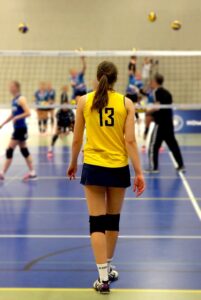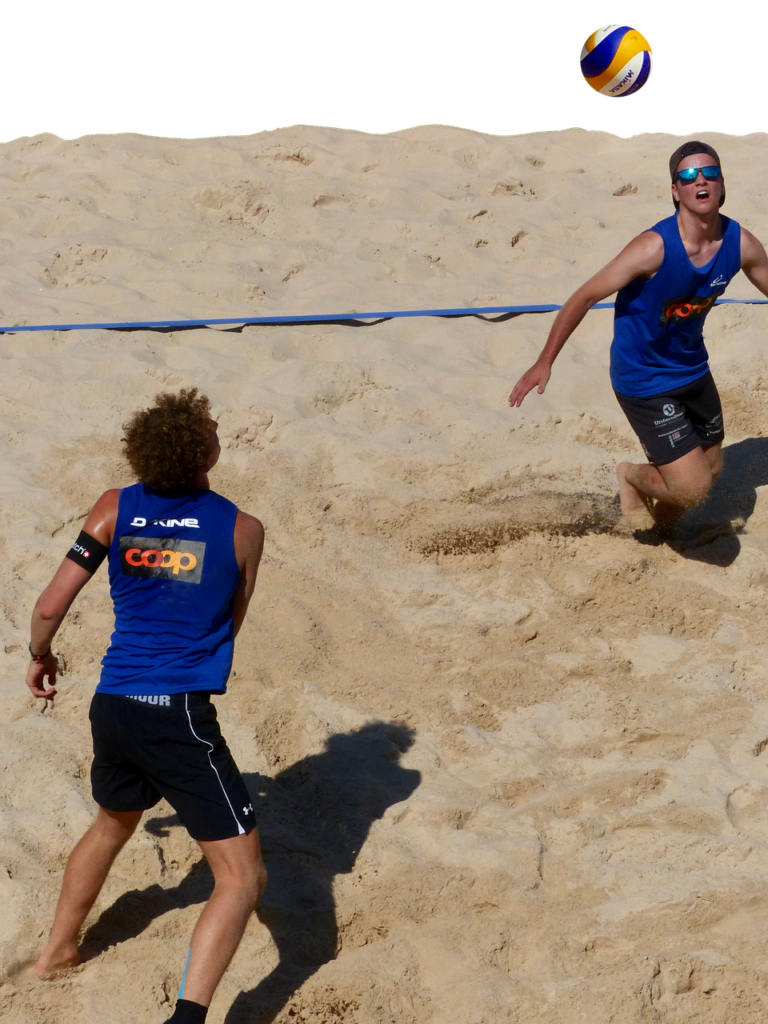Can you use your head in volleyball? In volleybally, players generally use their arms and hands to dive, spike, and set. But sometimes, we wonder if we can use head in the game. In this blog post, we look into the complexities of using head in volleyball. Let’s investigate the benefits and drawbacks of this unique strategy, from knowing the basic rules and regulations to learning the tips and techniques.
Can You Use Your Head In Volleyball?
Yes, it is legal to contact the ball with any part of the body. Volleyball players are allowed to use any part of their body, including their head, to strike the ball as per the official rules. However, for a head touch to be accepted as lawful, certain requirements must be fulfilled: They are as follows:
Clean Contact:
There must be clean contact between the head and the ball, without any extended ball manipulation or contact.
Intentional Play:
The head must be used deliberately, not by accident. It is not deemed a lawful play if a player’s head accidentally makes contact with the ball.

Setting with the Head:
In some circumstances, players may decide to set the ball using their heads. Setting with the head is governed by similar laws to setting with the hands. For a head set to be considered lawful, the following requirements must be satisfied:
Double Contact:
The ball cannot touch different portions of the head in succession, much like with a hand set. To prevent double hits, a player should make a clean, controlled contact.
Directional Accuracy:
Without excessive spin or erratic movement, the head set should be directed properly to the intended target.
Using the Head to Block:
Even though the hands are usually used for blocking, players occasionally inadvertently block balls with their heads. Intentional acts are not regarded as lawful, much like other head interactions.
For a head block to be deemed legitimate, the player must possess a distinct purpose to block the ball with their head. The laws governing inadvertent touches in other contexts apply equally to unintentional head contact during a block.
At The Referee’s Option:
Referees have the authority to exercise their discretion when there is uncertainty regarding the interpretation of the rules or when unusual circumstances occur. The spirit of the game and the players’ safety will be taken into consideration by referees while making decisions.

Advantages Of Using Your Head In Volleyball
Quick Reaction Time:
The capacity to respond swiftly to unforeseen circumstances is one of the main benefits of using the head in volleyball. A player may be able to keep the ball in play at the last minute by using their head as an intuitive reaction when the ball is approaching at an odd angle or an unexpected speed.
Surprising Opponents:
Using your head in the right circumstances can surprise opponents. The unexpected use of the head can provide an element of surprise, making it harder for the opposing side to predict the trajectory of the ball, since most players anticipate using their hands or forearms.
Extended Reach:
The head can be a useful instrument for grabbing balls that are just out of reach for the hands or arms. When it comes to saving a point or keeping the ball in play during a rally, this increased reach can be really useful.
Versatility:
On the court, players who are skilled at using several body parts, particularly the head, display versatility. This adaptability can be useful in a variety of gaming scenarios, enabling a more lively and erratic style of play.
Disadvantages Of Using Your Head In Volleyball
Accuracy Concerns:
Comparing utilizing the head to using the hands or forearms in volleyball, the main disadvantage is the inherent lack of accuracy. You run a higher chance of sending the ball off course or out of bounds because it is difficult to control precisely because of the spherical form of the head.
Injury Risks:
Players who manipulate the ball with their heads frequently run the danger of getting hurt. Particularly when done quickly, collisions with the ball can cause neck strains, concussions, and other problems with the head. The key to reducing these dangers is using the right technique and training.
Rule Limitations:
The use of the head is subject to particular rules and regulations in organized volleyball competitions. Using the head can occasionally lead to a mistake or a point loss, which makes it less viable as a constant playing tactic.
Restricted Possibilities for Offense:
Although it provides limited offensive options, using the head can be helpful in defensive scenarios. Attacking shots with the head gives players less control over the direction and speed of the ball, which makes it a less desirable option for offensive play.

Achieving Accuracy Through Practice:
Effective head use in volleyball requires practice, just like any other talent. Commence with basic exercises emphasizing precise and controlled contact. To improve your head touches’ precision, practice guiding the ball to particular targets on the court.
Give Attention to Timing:
When using your head in volleyball, timing is essential. To make a timely contact, anticipate the trajectory of the ball and adjust your position accordingly. Perfecting this talent is crucial because even a small miscalculation in timing might make a play useless.
Preserving a Steady Head and Body Position:
The secret to successful head touches is maintaining a steady neck and body position. Steer clear of needless head movement or tilting as this can result in incorrect contact. To guarantee a precise and controlled touch, maintain your body’s equilibrium and focus on the ball.
Controlling with the Forehead:
The forehead is the flattest area of the head, therefore use it to make contact with the ball. More surface area is available for a more controlled touch thanks to this. Compared to other areas of the head, the forehead enables more precise ball direction.
Including Head Sets in Instruction:
Just as you would with hand setting, practice head setting. Gain the ability to use your head to accurately pass the ball to your teammates. When handling the ball at an unusual angle or in other situations where utilizing the hands is difficult, this skill can be especially helpful.
Understanding When to Use Your Head:
It’s important to know when to apply your judgment. Using your head may be the best course of action in fast-paced scenarios or when the ball is too low for hand contact. Making quick and wise decisions will be aided by your awareness of your surroundings, as well as the positions of your opponents and teammates.
Combining Skills:
Successful volleyball players typically have a smooth integration of several skills. Develop a smooth transition between utilizing your hands and your head. Your capacity to adapt will help you become a more proficient player who can handle a variety of plays and opponents.
Building Confidence:
An important component of any sporting performance is confidence. Your confidence will naturally increase as you hone your head-touch techniques. Have faith in your skills and don’t be afraid to apply common sense when necessary.
Safety First:
While it’s vital to perfect head touches, safety should come first. To protect yourself and others from harm, do not use your head in an excessively violent or careless manner. To guarantee a fun and safe gaming experience, abide by the game’s rules and restrictions.
Conclusion
Can you use your head in volleyball? If you follow the rules, using your head in volleyball is acceptable. Advantages including rapid reflexes, surprise tactics, and greater reach are advantageous to players. The disadvantages are, however, limited attacking options, rule restrictions, injury risks, and accuracy problems. Practice is necessary for the successful integration of head play; pay attention to body position, timing, and accuracy. Safety should come first even though confidence is crucial. In conclusion, volleyball players can strategically use their heads, but careful evaluation of the situation and potential consequences is essential for efficient performance.
Is headshot a foul in volleyball?
No, if a headshot is accidental, it’s usually not regarded as a foul in volleyball. A player may, however, be in breach if they purposefully use their head to play the ball.
Does volleyball cause many head injuries?
No, volleyball generally does not cause many head injuries compared to contact sports like football or soccer. Head injuries in volleyball are less common due to the regulations and nature of the game.
Can you head bump in volleyball?
Yes, volleyball players can perform a “volleyball bump” or “bump,” in which they strike the ball with their forearms.
Can you get a concussion from a volleyball hitting your head?
Although it is uncommon, striking your head on a volleyball can cause a concussion. Direct, hard blows from the ball to the head can result in concussions. .
Why does my head hurt after getting hit with a volleyball?
When you get struck by a volleyball, your head may hurt because the force of the strike causes brain trauma and headaches. The impact of the ball hitting your head may cause a mild concussion.
